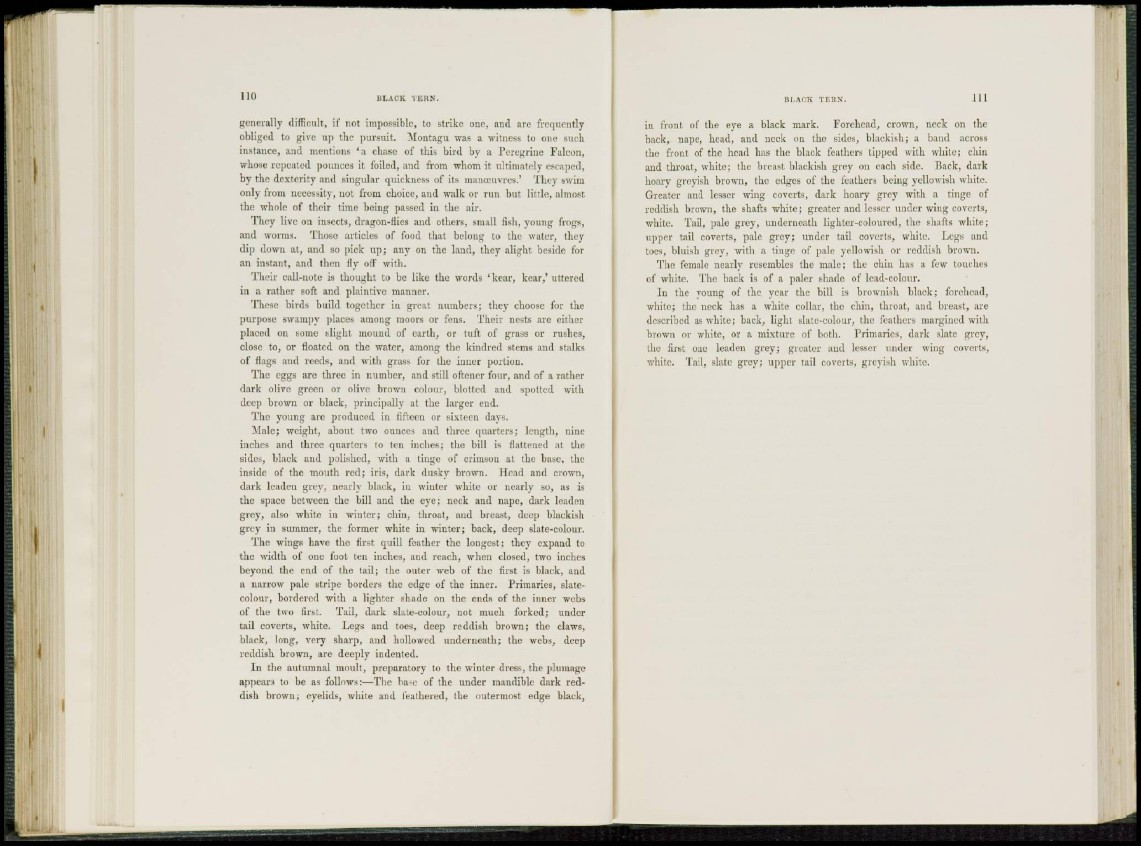
1 10 BLACK TERN.
generally difficult, if not impossible, to strike one, and are frequently
obliged to give up the pursuit. Montagu was a witness to one such
instance, and mentions ' a chase of this bird by a Peregrine Falcon,
whose repeated pounces it foiled, and from whom it ultimately escaped,
by the dexterity and singular quickness of its manoeuvres.' They swim
only from necessity, not from choice, and walk or run but little, almost
the whole of their time being passed in the air.
They live on insects, dragon-flies and others, small fish, young frogs,
and worms. Those articles of food that belong to the water, they
dip down at, and so pick up; any on the land, they alight beside for
an instant, and then fly off with.
Their call-note is thought to be like the words ' k e a r , kear,' uttered
in a rather soft and plaintive manner.
These birds build together in great numbers; they choose for the
purpose swampy places among moors or fens. Their nests are either
placed on some slight mound of earth, or tuft of grass or rushes,
close to, or floated on the water, among the kindred stems and stalks
of flags and reeds, and with grass for the inner portion.
The eggs are three in number, and still oftener four, and of a rather
dark olive green or olive brown colour, blotted and spotted with
deep brown or black, principally at the larger end.
The young are produced in fifteen or sixteen days.
Male; weight, about two ounces and three quarters; length, nine
inches and three quarters to ten inches; the bill is flattened at the
sides, black and polished, with a tinge of crimson at the base, the
inside of the mouth red; iris, dark dusky brown. Head and crown,
dark leaden grey, nearly black, in winter white or nearly so, as is
the space between the bill and the eye; neck and nape, dark leaden
grey, also white in winter; chin, throat, and breast, deep blackish
grey in summer, the former white in winter; back, deep slate-colour.
The wings have the first quill feather the longest; they expand to
the width of one foot ten inches, and reach, when closed, two inches
beyond the end of the tail; the outer web of the first is black, and
a narrow pale stripe borders the edge of the inner. Primaries, slatecolour,
bordered with a lighter shade on the ends of the inner webs
of the two first. Tail, dark slate-colour, not much forked; under
tail coverts, white. Legs and toes, deep reddish brown; the claws,
black, long, very sharp, and hollowed underneath; the webs, deep
reddish brown, are deeply indented.
I n the autumnal moult, preparatory to the winter dress, the plumage
appears to be as follows:—The base of the under mandible dark reddish
brown; eyelids, white and feathered, the outermost edge black,
BLACK TERN. I l l
in front of the eye a black mark. Forehead, crown, neck on the
back, nape, head, and neck on the sides, blackish; a band across
the front of the head has the black feathers tipped with white; chin
and throat, white; the breast blackish grey on each side. Back, dark
hoary greyish brown, the edges of the feathers being yellowish white.
Greater and lesser wing coverts, dark hoary grey with a tinge of
reddish brown, the shafts white; greater and lesser under wing coverts,
white. Tail, pale grey, underneath lighter-coloured, the shafts white;
upper tail coverts, pale grey; under tail coverts, white. Legs and
toes, bluish grey, with a tinge of pale yellowish or reddish brown.
The female nearly resembles the male; the chin has a few touches
of white. The back is of a paler shade of lead-colour.
I n the young of the year the bill is brownish black; forehead,
white; the neck has a white collar, the chin, throat, and breast, are
described as white; back, light slate-colour, the feathers margined with
brown or white, or a mixture of both. Primaries, dark slate grey,
the first one leaden grey; greater and lesser under wing coverts,
white. Tail, slate grey; upper tail coverts, greyish white.